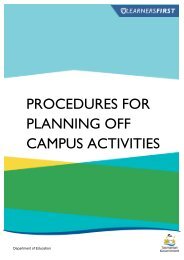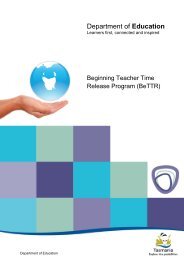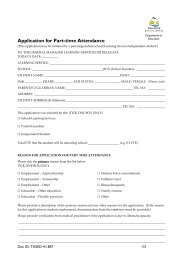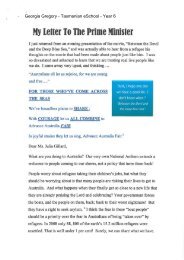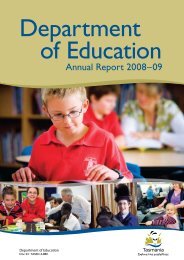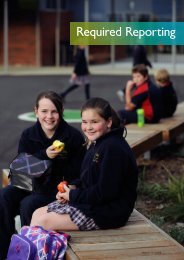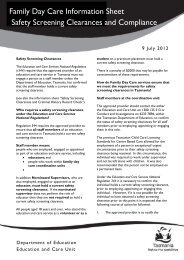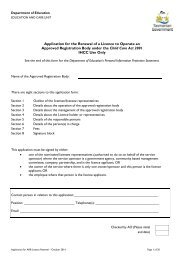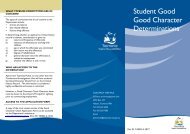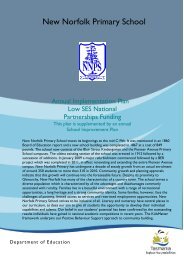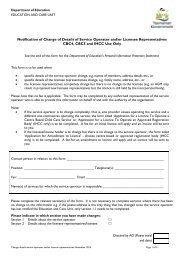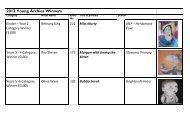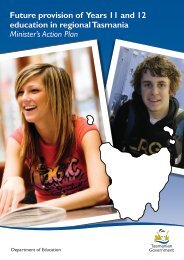Tas Curriculum K-10 - Languages - Italian - Department of Education
Tas Curriculum K-10 - Languages - Italian - Department of Education
Tas Curriculum K-10 - Languages - Italian - Department of Education
You also want an ePaper? Increase the reach of your titles
YUMPU automatically turns print PDFs into web optimized ePapers that Google loves.
Assessment indicators – alphabetic languages<br />
Communication<br />
Language as a system<br />
Listening<br />
Speaking<br />
Reading<br />
Writing<br />
Standard four: Demonstrates comprehension <strong>of</strong> main ideas and some supporting details in social<br />
interactions and in a variety <strong>of</strong> spoken texts<br />
Stage <strong>10</strong> Stage 11 Stage 12<br />
listens to a spoken text, e.g. an advertisement, and identifies on a teacher checklist,<br />
characteristics <strong>of</strong> the advertised product e.g. price, size, colour, flavour<br />
listens to a description <strong>of</strong> the daily routine <strong>of</strong> a child from the target language culture and<br />
records the activities in sequence<br />
listens to several descriptions e.g. <strong>of</strong> holiday destinations and uses the available information to<br />
provide reasons for choosing one <strong>of</strong> the destinations<br />
identifies single or separate items <strong>of</strong> information in a series <strong>of</strong> short spoken texts e.g. questions<br />
and answers around the class<br />
shows understanding <strong>of</strong> short texts containing recently rehearsed language and some prior<br />
learning e.g. responding to recorded texts<br />
Standard four: Asks for and provides information and opinions about self and others, people,<br />
places or events including in short conversations<br />
Stage <strong>10</strong> Stage 11 Stage 12<br />
prompts and provides responses in information gap exercises<br />
answers questions on nominated topics using previously rehearsed structures<br />
gives instructions e.g. for making a recipe<br />
gives a short talk on a prepared topic e.g. heroes or sport, using prompts<br />
performs short role plays e.g. an interview with a famous personality<br />
reads aloud paying attention to fluency, pronunciation and intonation<br />
Standard four: Reads a variety <strong>of</strong> texts containing some unfamiliar language and identifies key ideas<br />
and some supporting information<br />
Stage <strong>10</strong> Stage 11 Stage 12<br />
completes cloze, information-gap and matching exercises selecting from a bank <strong>of</strong> words or<br />
phrases<br />
distinguishes between main ideas and supporting information<br />
sequences sentences in a procedural text e.g. recipe<br />
shows understanding <strong>of</strong> text e.g. by answering questions, completing a table, sequencing<br />
information<br />
uses available resources to decipher meaning <strong>of</strong> unknown words e.g. bilingual dictionaries<br />
Standard four: Applies familiar linguistic patterns and structures to link and sequence information<br />
and ideas in written texts<br />
Stage <strong>10</strong> Stage 11 Stage 12<br />
creates an invitation for a special event, writing in the appropriate format<br />
finds words or phrases to complete tasks e.g. cloze, information-gap and matching exercises<br />
expresses opinions and uses modeled sentence structures to support personal views e.g. music,<br />
leisure activities, film stars, clothing, environmental issues<br />
extends well-rehearsed language patterns to new contexts e.g. writes a letter or postcard<br />
writes linked sentences to form a short paragraph or dialogue<br />
Standard four: Recognises and uses correct patterns in the target language in familiar situations<br />
without cues<br />
applies strategies to decipher meaning <strong>of</strong> new words from context and textual resources e.g. uses<br />
online dictionaries and teamwork<br />
identifies and compares features <strong>of</strong> some text types in English and the target language e.g. brochure<br />
observes the relevant text conventions e.g. appropriate format, punctuation<br />
plans and edits own work and with peer e.g. checks for correct use <strong>of</strong> a specific structure<br />
develops and explains strategies for internalising new language and building on prior knowledge e.g.<br />
mnemonic devices, cue cards, Look Say Cover Write Check<br />
75



